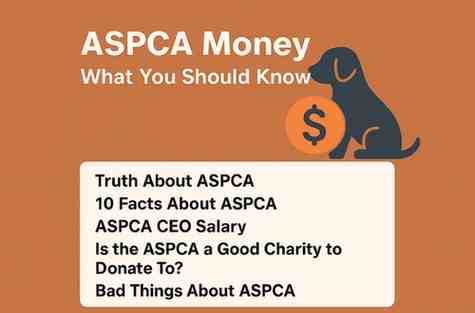ASPCA Money: What You Should Know
Whenever individuals inquire about the ASPCAs money, they tend to question how much money the organization is able to raise, how they spend the money, and how much it actually does good to animals. This is a profound insight into the American Society to Prevent Cruelty to Animals (ASPCA) – its history, expenditure, scandals and influence of donation.
What Is the ASPCA? (ASPCA History)
The ASPCA is the short name, which is translated as the American Society for the Prevention of Cruelty to Animals. Henry Bergh, a man, established it in the year 1866 in New York City, April 10. It aims at ensuring that animals are not subjected to inhumanity in the United States.
Throughout the years, the ASPCA has been involved in rescue, veterinary services, advocacy, investigations, education of people and grant giving. Between 1866 and 2013, it had a humane law enforcement department in New York which dealt with cruelty cases before the role was passed to other agencies.
Truth About ASPCA
When individuals seek to find out the truth about ASPCA, they would desire to know where their money goes. According to the organization, approximately 75 cents of each dollar is spent on lifesaving initiatives however critics assert that that amount also features fundraising and advocacy projects and not direct animal care.
Other watchdogs have expressed some concerns over the acceptance of funds with some appearing to go to shelters or veterinary programs. Although ASPCA is still a leading animal advocacy group, there are still transparency and allocation issues.
10 Facts About ASPCA
Founded in 1866 by Henry Bergh after New York passed its first animal cruelty law.
Operates nationwide through grants, shelters, rescue operations, and advocacy work.
Generates hundreds of millions in annual revenue and holds large assets.
CEO compensation exceeds $1 million, raising concerns among some donors.
Executive pay has grown steadily over recent years.
Direct grants to shelters make up only a small percentage (often 1–2%) of total spending.
Fundraising expenses reach tens of millions annually.
Former executives have raised concerns about internal spending and management practices.
Watchdog ratings are mixed, with some assigning average efficiency grades.
Emotional TV ads have raised millions, but also sparked ethical debates over donor expectations.
ASPCA CEO Salary
ASPCA’s CEO, Matthew Bershadker, reportedly earns more than $1.2 million per year, including salary, bonuses, and benefits. The high compensation has drawn criticism, especially when compared with smaller, local shelters that operate on limited budgets.
While some argue that large organizations require experienced leadership, others feel such salaries contradict donor expectations for a nonprofit.
Is the ASPCA a Good Charity to Donate To?
Whether the ASPCA is a “good” charity depends on your goals as a donor.
Reasons to Support:
Large scale and reach — nationwide programs and resources.
Advocacy and systemic impact — works to change laws and policies protecting animals.
Professional management — well-established programs and reporting.
Reasons to Reconsider:
High fundraising and overhead costs.
Low percentage of funds going directly to shelters.
High executive compensation.
Recent internal controversies and whistleblower claims.
If your priority is direct local impact, smaller community-based shelters might deliver more visible results per dollar donated. However, for large-scale animal protection and advocacy, ASPCA remains influential.
Bad Things About ASPCA
Low local shelter funding: Only a small portion of total revenue is given as grants to local animal shelters.
Heavy fundraising spending: Tens of millions are used annually on marketing and donor outreach.
High executive pay: Top salaries exceed those of most nonprofit leaders.
Transparency issues: Some insiders have alleged poor oversight and questionable contracts.
Whistleblower lawsuits: A former CFO claimed retaliation and misuse of donor money.
Mission drift: Critics say the ASPCA has shifted focus from direct rescue to large-scale advocacy.
Emotional advertising: Some feel the ads mislead donors about where their money goes.
Brand partnerships: Commercial deals, like pet insurance, blur lines between charity and business.
These criticisms don’t mean the ASPCA is fraudulent — but they do highlight why donors should research before giving.
ASPCA Donations: How the Money Is Used
ASPCA takes in donations in the form of one-time gifts, monthly donation, planned giving, memorial gift, and even vehicle or crypto donations.
It claims that approximately 75 percent of the expenditure is on programs such as rescue, veterinary care and advocacy according to its reports. The independent analysts however estimate that only a little part of it directly funds the animal shelters with substantial part of it going to fundraising, marketing and salaries.
In 2023, the ASPCA allegedly collected approximately 379 million and expended approximately 355 million, such as more than 78 million on fundraising and 1.2 million on the pay of the CEO.
ASPCA Charity Percentage
The percentage of charity normally implies the percentage of every dollar that is allocated to mission work as compared to administrative or fundraising expenses. ASPCA asserts about 75% spend on the programs, with watchdogs estimating that it is more about 60% or less when you reduce the mission to direct animal care.
Simply put, it is a matter of definition regarding the true number on program spending. The ASPCA includes advocacy, marketing and education in their mission, but many of the donors will think that programs refer to direct animal rescue and shelter care.
Final Thoughts: Should You Donate to the ASPCA?
ASPCA has already made much effort in the protection of animals, legislation and rescue. It possesses enormous resources, good branding and national value but it is also right to be criticized at the same time due to excessive overheads and executive compensation.
